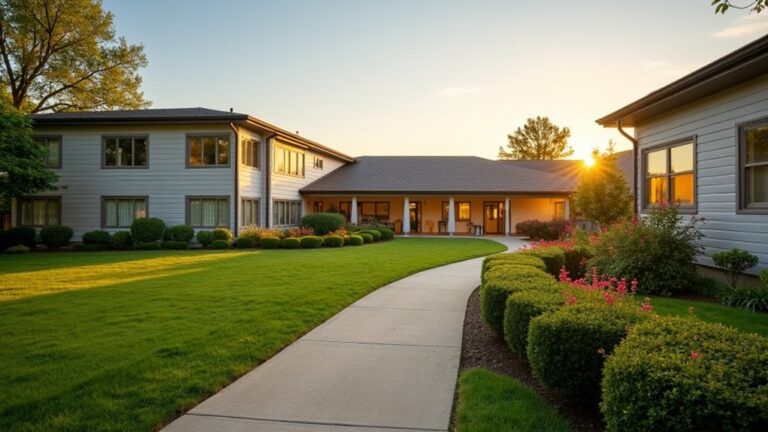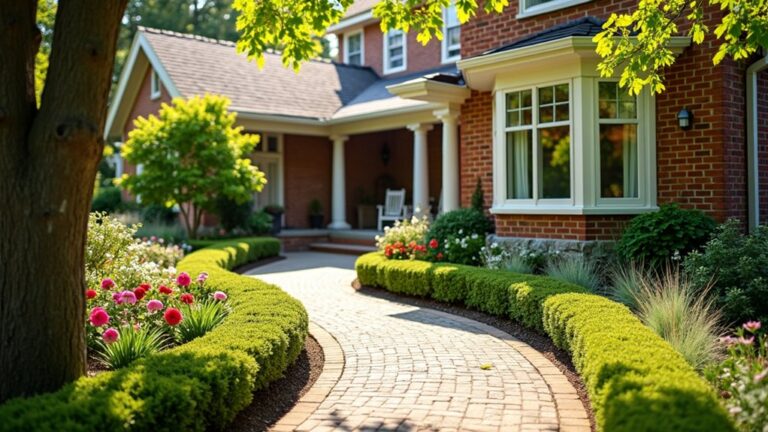Navigating Compliance for Residential Care Homes

Steering through compliance for residential care homes can feel overwhelming, but you’ve got this! Start by familiarizing yourself with local regulations and licensing requirements to guarantee your operations are legit. Uphold health and safety standards, like fire codes and sanitation protocols, to protect everyone. Train your staff regularly and prioritize resident rights with clear policies. Keep records meticulous for inspections. Stick around to uncover more tips for mastering this complex maze with ease!
Key Takeaways
- Understand regional regulatory frameworks to ensure compliance with health and social care standards.
- Secure necessary licenses by submitting detailed applications and meeting operational criteria.
- Uphold health and safety standards, including fire safety and sanitation protocols.
- Provide staff with mandated training and maintain updated certifications for inspections.
- Protect resident rights through clear policies and staff training on mistreatment recognition.
Understanding Regulatory Frameworks for Care Homes

As you immerse yourself in managing a residential care home, grasping the regulatory frameworks is essential. You’re dedicated to serving others, and understanding these guidelines guarantees you provide safe, compassionate care.
Start by familiarizing yourself with the overarching standards set by health and social care authorities. These rules protect residents and staff, shaping how you create a nurturing environment. Engage with policies on resident rights, safety protocols, and quality of care—they’re your roadmap to excellence.
Dive into the essential standards from health and social care authorities. They safeguard everyone and guide you in fostering a nurturing, exceptional care environment.
You’ll need to stay updated on changes in regulations, as they evolve to meet new challenges in care. Connect with local care networks or attend workshops to deepen your knowledge. Levels of care in assisted living communities can provide valuable insights into best practices.
Don’t hesitate to ask questions or seek guidance from regulatory bodies; they’re there to support your mission. By prioritizing compliance, you’re not just meeting standards—you’re building trust and making sure every resident feels valued, safe, and truly cared for in your home.
Key Licensing Requirements for Operations
While running a residential care home, you must prioritize securing the right licenses to operate legally and safely. Your commitment to serving others starts with meeting these essential requirements, guaranteeing your facility is recognized as a trusted place of care.
Begin by identifying the specific licensing body in your state or region, as regulations can vary widely. You’ll need to submit detailed applications, often including background checks for staff and proof of proper training.
Next, confirm you meet the operational criteria set by the licensing authority, such as maintaining accurate resident records and adhering to staffing ratios. Additionally, ensure that you provide personalized care plans to cater to the unique needs of each resident, enhancing their quality of life.
Don’t overlook renewal deadlines—failing to renew on time can jeopardize your ability to serve. Stay proactive by keeping updated on any changes in licensing laws.
Health and Safety Standards to Uphold

Beyond licensing, you must prioritize health and safety standards to protect everyone in your residential care home. As someone dedicated to serving others, you’re committed to creating a secure environment.
Start by ensuring your facility meets fire safety codes—install smoke alarms, maintain fire extinguishers, and map out clear evacuation routes. Regularly inspect these systems to keep them functional.
Next, focus on sanitation. Keep living spaces clean to prevent infections, and enforce strict hygiene protocols for food preparation. Don’t overlook medication storage—secure it properly to avoid misuse.
Also, assess your home for fall hazards; install grab bars and remove tripping risks to safeguard residents.
Finally, maintain proper documentation of safety drills and incident reports to stay compliant and prepared. By upholding these standards, you’re not just meeting regulations—you’re showing genuine care for those who depend on you every day. Additionally, understanding the breakdown of expenses associated with care can help in budgeting for necessary safety improvements.
Staff Training and Certification Mandates
Ensuring health and safety standards sets a strong foundation, but you also need to focus on staff training and certification mandates to maintain compliance in your residential care home.
Your team’s skills directly impact the quality of care you provide, so prioritize their education. Make sure every staff member completes required training programs, often mandated by state regulations, covering essential topics like emergency response, infection control, and medication administration.
Don’t overlook certifications—verify that credentials are up to date and relevant to their roles.
You’ve got to create a culture of continuous learning. Encourage ongoing professional development through workshops or online courses to keep skills sharp. Additionally, fostering socialization opportunities can enhance staff interactions, improving the overall care environment.
Document all training meticulously; regulators may request proof during inspections. By investing in your staff’s growth, you’re not just meeting mandates—you’re enhancing the lives of those you serve with compassionate, competent care every day.
Resident Rights and Protection Policies

As you focus on compliance in your residential care home, remember that safeguarding resident rights and protection policies is just as critical as staff training. You’re entrusted with the well-being of vulnerable individuals, so prioritize their dignity, privacy, and safety.
Confirm you’ve got clear policies outlining residents’ rights to make choices, express themselves, and live free from abuse or neglect. Communicate these rights to both residents and staff, fostering a culture of respect.
Ensure policies clearly define residents’ rights to choose, express, and live without abuse or neglect, while promoting a respectful environment for all.
You must also establish robust protection measures. Implement strict protocols to prevent harm, including background checks for staff and immediate response plans for any concerns. Train your team to recognize signs of mistreatment and act swiftly. Reporting abuse or neglect is crucial for ensuring residents receive proper care and attention.
Encourage open dialogue so residents feel safe voicing issues. By actively upholding these standards, you’re not just meeting requirements—you’re showing true compassion and commitment to those in your care every single day.
Regular Inspections and Audit Processes
Take a proactive stance on compliance by prioritizing regular inspections and audit processes in your residential care home. You’re dedicated to serving others, and maintaining high standards guarantees the safety and well-being of your residents.
Schedule routine inspections to identify potential issues before they escalate. Check everything from cleanliness to staff training, and don’t overlook safety protocols. These steps show your commitment to providing a nurturing environment.
Beyond inspections, conduct thorough audits to review policies and documentation. Confirm you’re meeting regulatory requirements and addressing resident needs. Ensuring compliance with levels of care is essential in delivering appropriate support to each resident.
Involve your team in these processes—they’re your partners in care. Use audit findings to improve operations and train staff, reinforcing a culture of excellence.
Frequently Asked Questions
How Can Families Choose the Right Care Home?
Wondering how to choose the right care home for your loved one? Start by researching facilities that match their needs—look at location, services, and staff qualifications.
Visit each home, ask questions, and observe the environment. Don’t hesitate to talk to residents and families for honest feedback.
Trust your instincts, and prioritize a place where compassion shines. You’re ensuring their comfort, so take your time to decide wisely!
What Are the Costs of Residential Care Services?
Wondering about the costs of residential care services? You’re not alone.
Explore understanding these expenses by researching average fees, which can range from $3,000 to $8,000 monthly, depending on location and care level.
Don’t hesitate to ask facilities for detailed breakdowns. Compare costs against the quality of care provided.
You’re helping loved ones, so make sure you’re informed. Reach out to financial advisors if you’re unsure about funding options.
How Are Meal Plans Customized for Residents?
Hey, let’s talk about how you can customize meal plans for residents.
You’ll assess their dietary needs, preferences, and any medical restrictions first. Then, work closely with nutritionists to craft menus that nourish and delight.
Don’t forget to include cultural or personal favorites to make meals special. Regularly check in with residents for feedback, and adjust plans as needed.
Your dedication guarantees they feel cared for and valued every day.
What Activities Are Offered for Resident Engagement?
Hey, you’re curious about what activities are offered for resident engagement, right?
Immerse yourself and explore a variety of options designed to bring joy and connection! You’ll organize games like bingo, facilitate arts and crafts sessions, and arrange music therapy to uplift spirits.
Don’t forget outdoor walks or gardening for fresh air. You’re creating meaningful moments, fostering community, and ensuring every resident feels valued and engaged every single day!
How Is Family Visitation Managed in Care Homes?
Wondering how family visitation is managed in care homes? You’re key to making it work!
Schedule visits in advance to guarantee everyone’s safety and comfort. Follow the home’s guidelines on timing and visitor numbers—don’t hesitate to ask questions.
Bring warmth and love during your time, as it means the world to residents. Check if virtual visits are an option too.
You’re helping create precious, meaningful connections every visit!






